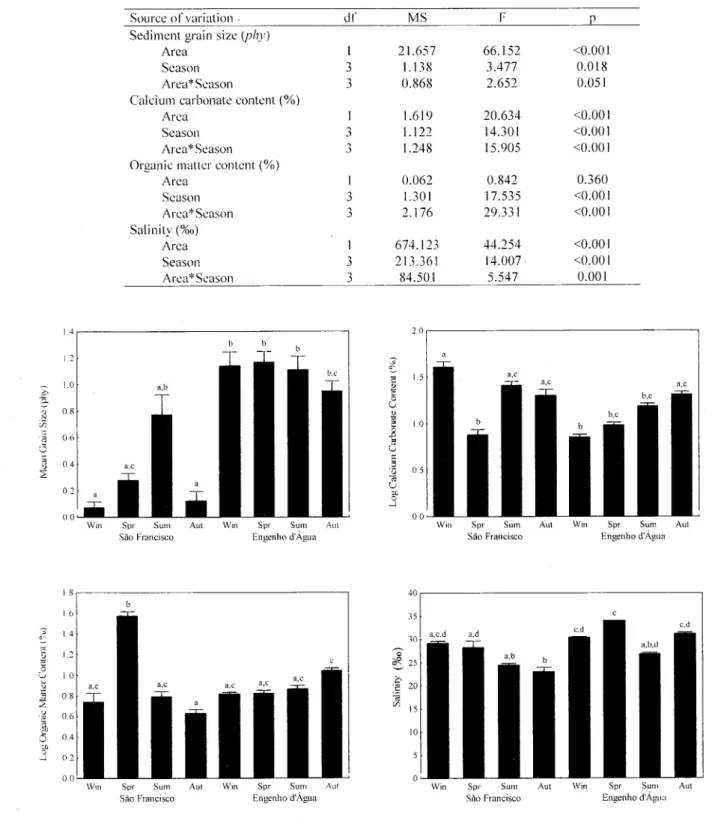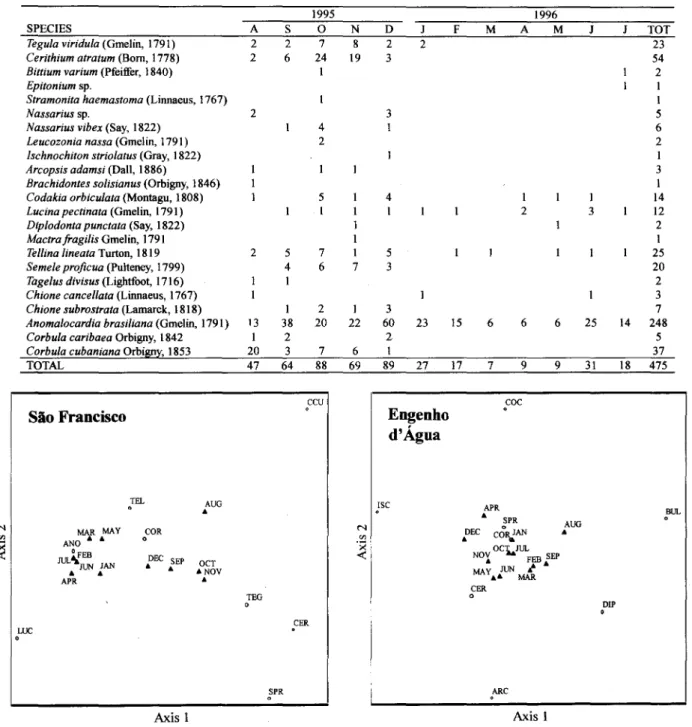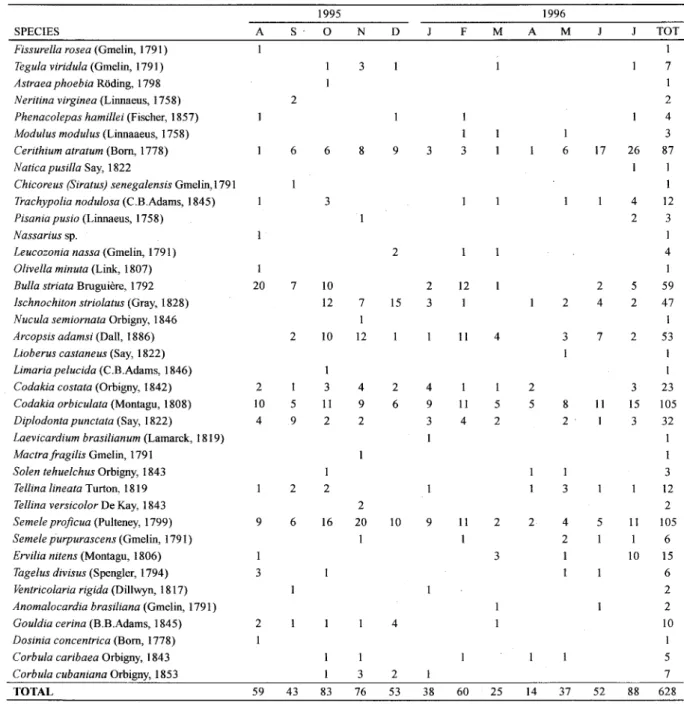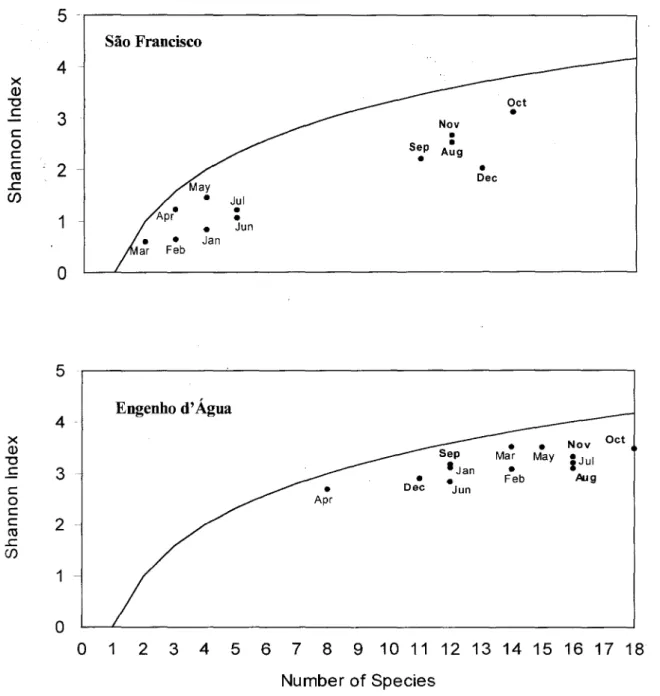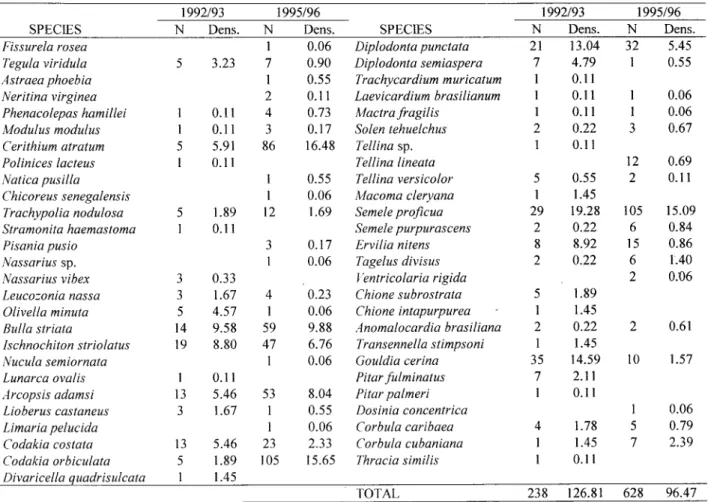Rev. bras. oceanogr.. 48(2):141-150. 2000
Annual variation of the malacofauna on two intertidal sandy substrates
with rock fragments in southeastern Brazil
Marcia R. Denadai1,2;A. Cecília Z. Amarall & Alexander Turral,3
'Instituto de Biologia, UNICAMP Departamento de Zoologia
(Caixa Postal 6109, 13.083-970, Campinas, SP, Brasil)
2Pós-Graduação em Zoologia. marciard@hotmail.com (corresponding author)
3Pós-Graduação em Ecologia. turra@unicamp.br
.
Abstract: The temporal variation in molluscan communities was studied in two intertidal substrates composed of sand and rock fragments «300 mm) in São Sebastião Channel, Brazil. Samples were taken between August 1995 and July 1996 in São Francisco (mainland) and Engenho d'Água (São Sebastião Island) beaches. A pronounced decrease in abundance and diversity of molluscs was associated with changes in the structure of the environment, caused by sea storms in the beginning of the summer (December), and by the increase of waste water discharge in this same period. Areas not subjected to such events showed no evident modifications in mollusc fauna structure during the sampling period, and the small oscillations observed were attributed to population recruitment. Both natural and human factors may be acting together in determining the community organization in these environments, as is also in typical sandy beaches..
Resumo: Estudou-se a variação anual da comunidade de moluscos em dois ambientesentremarés constituídos por areia e fragmentos rochosos «300 mm) no Canal de São Sebastião, Brasil. As amostras foram obtidas mensalmente entre agosto de 1995 e julho de 1996 nas praias São Francisco (continente) e Engenho d'Água (Ilha de São Sebastião). Uma marcante redução na abundância e diversidade foi associada às mudanças estruturais do ambiente, causada por ressacas do mar no início do verão (dezembro), e ao aumento no fluxo de esgotos domésticos neste período. Em áreas onde estes eventos não foram evidentes, não houve grande alteração na composição faunística, e as pequenas oscilações foram atribuídas ao recrutamento de populações numericamente importantes. Ambos os fatores naturais e antrópicos podem estar atuando em conjunto para determinar a organização da comunidade nestes ambientes, tal como ocorre em praias arenosas típicas.
.
Descriptors:Molluscs, Annual variation, Environmental disturbances, Sandy substrates with rock fragments, São ~ebastião Channel, Brazil..
Descritores: Moluscos, Variação anual, Distúrbios ambientais, Praias arenosas com fragmentos rochosos, Canal de São Sebastião, Brasil.Introduction oscillations in diversity and community composition
in coastal regions can be associated to human activities. Most of these activities can be easily detected and monitored, but some, such as oil spills, are unpredictable.
142 Rev. bras. oceanogr., 48(2). 2000
Many studies in sandy beach communities assign to natural oscillations in the abundance of numerically dominant popu]ations as the cause of temporal variation ofmacrofauna (Holland & Po]gar, ]976; Dexter, 1984; Souza & Gianuca, ]995; Ve]oso et a!., ]997). In temperate regions, the community composition is strong]y influenced by temperature (Whitlatch, ]977; Leber, ]982), which is directly related to food limitation. Seasonality in tropical areas is generally re]ated to rain periods (Dexter, ]979) and to disturb instead of temperature changes. Macrofauna is directly influenced by changes in the sediment constitution (McLach]an, ]996) and in salinity (Ansellet ai., ]972; Ansari et a!., ]986, Defeo & de Alava, ]995), beach erosion (Ansellet ai., ]972, Ong & Krishnan, ]995), organic enrichment (Beukema, 199]; Tsutsumi et ai., ]991), and fisher activity (Defeo & de A]ava,
]995). .
Studies on sandy substrates constituted by rock fTagments as well as knowledge of the factors that organize their communities are lacking. The presence of rock fTagments enhances environmenta] heterogeneity and creates moist and shady microhabitats (pers. obs.). According to Woodin (] 98]), the patterns of distribution and abundance of macrofauna are fTequently correlated with environmental heterogeneity, i. e., presence and abundance of physical and/or biogenic structure. These rock fTagmentscan a]so protect the organisms against desiccation, predation, and water movements, and, in association with sand, enable the settlement and recruitment of both sandy beach and rocky shore organisms (Denadai & Amaral, 1999).
Furthermore, in some intertida] rocky shores inundated by sand, the structura] change in the substrate may cause an increase in the faunal diversity because of the higher environmenta] heterogeneity (McQuaid & Dower, ]990). On the other hand, the exc1usion of psammophobic species (not to]erant to sand) may cause a reduction in the richness and abundance (Brownet a!.,]99]).
]n this study we describe the annua] variation in the molluscan communities, and the factors which influence it, oftwo structurally similar intertida] environments constituted by sand and rock fTagments (São Francisco and Engenho d'Água Beaches).
MateriaIs and methods
This study was conducted in two intertida] environments constituted by sand and rock tragments, São Francisco and Engenho d' Água, located in the São Sebastião Channel, northern coast
of São Paulo State, Brazil. Random samp]es were taken month]y between August] 995 and Ju]y ]996, during ]ow spring tides, tota]ing ]9.08 m2. The temperature (air and sediment), sa]inity of interstitia] water, sediment grain size and calcium carbonate and organic matter contents were a]so eva]uated. Refer to Denadai & Amara] (1999) for detai]ed description of the study area and sampling procedure. The molluscan individuaIs were identified to the ]owest taxonomic leve] possib]e using the current ]iterature that inc1udes Brazi]ian species (Warmke & Abbott, ]975; Abbott & Dance, ]99]; Rios, ]994).
Two-way ana]ysis of variance (ANOVA) was used to compare the environmenta] variab]es among the sites and months, followed by Scheffé's test (Zar, ]984). Ali tests were performed at the 0.05 significance ]evel. Ordination ana]ysis (Reciproca] Averaging) was used to interpret the temporal distribution. This analysis was performed using Hill's method (Hill, 1979), giving equa] weight to the species, considering outliers, and
standardizing the data by square-root
transformation. Diversity (H') was calcu]ated using the Shannon-Wiener index in ]Og2(Krebs, 1989). Student's t-test was used to compare the density of molluscs between the present study and that of Salvador (1995), which was performed in the same area and using the same methodo]ogy during the period 1992/93.
Results
DENADAIel ai.:Annual variation in intcrtidal malacolÜuna 143
Table 1. Two-way ANOV A for the en~cts 01'study are a (SF x Ei\). in São Sebastião ChanneL I3raziL and scasons (period August 1995 to .Iuly 1996) on sediment grain size, calciul1l carbonatc contcnt. organic malter contcnt. and salinity. (dC degrecs 01' fi'eedol1l; MS. mean square).
14
1.1 1.0
~> 3.
'0) 0.8 N V3
.~
.:5
0.1 00
\Vin Spr Sum Aut \Vin Spr Sum Au! São Francisco Engenho d'Água
I S
\Vin Spr Sum Aut São Francisco
\Vio Spr Sum ALI! Engenho d'Agua
2.0
I 5
0.5
\Vio Spr Sum Aut São Francisco
\Vin Spr Sum Aut Engenho d'Água
40
\Vio Wio Spr Sum Aut
Engenho d'Águ:J Spr Sum Aut
São Francisco
Fig. I. Comparison 01'mean values 01'salinity. sedimcnt grain size. calcium carbonate and organic malter contents between the two studied areas in São Sebastião ChanneL Brazil and among the seasons (period August 1995 to .Iuly 1996). Superscript labels indicatc the results 01' the ShcfTé's test for pairwise multiple comparisons. Similar labels indicate non-significant dilkrenccs fi)\' pair-\\isc cOl1lparisons. (Horizontal bars indicatc + I Standard erro!').
Source ofvariation . dI' MS F P
Sediment grain size(phy)
Area I 21.657 66.152 <0.001
Scason 3 1.138 3.477 0.018
i\rea* Season 3 0.868 2.652 0.051
Calcium carbonate content (%)
Area I 1.619 20.634 <0.001
Season 3 1.122 14.301 <0.001
i\rea*Season .J, 1.248 15.905 <0.001
Organic malter content (%)
Area I 0.062 0.842 0.360
Scason 3 1.301 17.535 <0.001
Arca *Season 3 2.176 29.331 <0.001
Salinity (%0)
Area I 674.123 44.254 <0.001
Season 3 213.361 14.007 <0.001
144
A reduction in community richness and abundance occurred in SF after January (Table 2). A total of22 species and 367 individuais were recorded in the first half of the studied period (August to December/95) compared to 9 species and 188 individuais collected from January to July/96 (Table 2). Correspondence analysis organized the species in
Rev. bras. oceanogr.. 48(2). 2000
two distinct groups: one with species that occurred only in the first period (Teguia viriduia, Cerithium atratum, Semeie proficua and Corbuia cubaniana), and another with species that were found over the entire year (Codakia orbiculata, Lucina pectinata, Tellina lineata and Anomaiocardia brasiliana),but in lower abundance after January (Fig. 2).
Table 2. Occurrence and abundance ofmolluscs along the year in São Francisco Beach, São Sebastião Channel, Brazil.
SPECIES A
Tegula viridula(Gmelin, 1791) 2
Cerithium atratum(Bom, 1778) 2
Bittium varium (Pfeiffer, 1840) Epitonium sp.
Stramonita haemastoma (Linnaeus, 1767)
Nassarius sp. 2
Nassarius vibex (Say, 1822) Leucozonia nassa (Gmelin, 1791) /schnochiton striolatus (Gray, 1822) Arcopsis adamsi (Dali, 1886)
Brachidontes solisianus (Orbigny, 1846) Codakia orbiculata (Montagu, 1808) Lucina pectinata (Gme1in, 1791) Diplodonta punctata (Say, 1822) Mactra fragilis Gmelin, 1791
TelJina lineata Turton, 1819 2 Semeie proficua (Pulteney, 1799)
Tagelus divisus (Lightfoot, 1716) Chione cancelJata (Linnaeus, 1767) Chione subrostrata (Lamarck, 1818)
Anomalocardia brasiliana (Gmelin, 1791) 13 Corbula caribaea Orbigny, 1842 1 Corbula cubaniana Orbigny, 1853 20
TOTAL 47
São Francisco
TE!.
.
.
AUGMAR MAY ANO
··
JULlfEB.
JUN JAN APR·
COR o OCT .NOV.
LUC
o 1995S O N
278
6 24 19
1 4 2 5 1 1 1 1 1
5 7 1
467 1
1 2 1
38 20 22
2
3 7 6
64 88 69
CCU
.
TEG o CER SPR D J 2 2 3 1996A M J TOT
23 54 2 1 1 5 6 2 1 3 1 14 12 2 1 25 20 2 3 7 14 248 5 37 18 475
F M J
3 1
4 1
1
2 31
5 3 3 60 23 2 1 89 27
6 6 25
15 6
7 9 9 31
17 Engenho d' Água COC
.
ISC.
.
APRSPR DEC o
.
CO~AN NOV OC~JUL.
FEB SEP MAY JUN
~.
CER.. MAR o BUL o AUG
.
DIP o ARC.
Axis 1 Axis 1
DENADAIet aI.:Annual variation in intertidal malacofauna
Higher values of richness and abundance were recorded in EA, with only a smali reduction fTomJanuary to May/96 (Table 3). Species were ordered in relation to their presence and abundance in the months (Fig. 2). A major group was formed by species that were fTequent during the entire year (Cerithium atratum, Arcopsis adamsi,
Codakia costata, C. orbiculata and Semeie
proficua). Other species as lschnochiton striolatus
(spring- October,Novemberand December),Bulla
striata (winter/spring - August, September, and
October) and Diplodonta punctata (earlier spring
-September) showed distinct seasonal distributions. ln general, the abundance decreased in the autumn
145
(March, April), but most of the species remained present.
Figure 3 shows the Shannon diversity index of the sampled months (abscissa) vs. the number of species (ordinate). The fitted line represents the log of the number of species, i.e., the highest diversity value that the community can attain for a given richness. The distance between points and this line is an indirect measure of evenness. Diversity in SF was higher fTom August to December than at other periods, but evenness was low for ali months. In EA, medium to high diversity values was recorded for ali sampling periods, but with low values in April. Evenness in EA was high in ali periods.
Table 3. Occurrence and abundance of molluscs along the year in Engenho d'Água Beach, São Sebastião Channel, Brazil.
SPECIES A
Fissurella rosea (Gmelin, 1791) I Tegula viridula (Gmelin, 1791)
Astraea phoebia Rõding, 1798 Neritina virginea (Linnaeus, 1758) Phenaeolepas hamillei (Fischer, 1857) Modulus modulus (Linnaaeus, 1758) Cerithium atratum (Bom, 1778) N atiea pusilla Say, 1822
Chieoreus (Siratus) senegalensis Gmelin, 1791 Traehypolia nodulosa (C .B.Adams, 1845) Pisania pusio (Linnaeus, 1758)
Nassarius sp.
Leueozonia nassa (Gmelin, 1791)
Olivella minuta (Link, 1807) I Bulia striata Bruguiere, 1792 20 lsehnoehiton striolatus (Gray, 1828)
Nueula semiornata Orbigny, 1846 Areopsis adamsi (Dali, 1886) Lioberus eastaneus (Say, 1822) Limaria pelueida (C.B.Adams, 1846)
Codakia eostata (Orbigny, 1842) 2 Codakia orbieulata (Montagu, 1808) 10 Diplodonta punetata (Say, 1822) 4 Laevieardium brasilianum (Lamarck, 1819) Maetra fragilis Gmelin, 1791
Solen tehuelehus Orbigny, 1843 Tellina lineata Turton. 1819 Tellina versieolor De Kay, 1843
Semeie projieua (Pulteney, 1799) 9 Semeie purpuraseens (Gmelin, 1791)
Ervilia nitens (Montagu, 1806) I Tagelus divisus (Spengler, 1794) 3 Véntrieolaria rigida (DilIwyn, 1817)
Anomaloeardia brasiliana (Gmelin, 1791) Gouldia eerina (B.B.Adams, 1845) 2 Dosinia eoneentriea (Bom, 1778) I Corbula caribaea Orbigny, 1843
Corbula eubaniana Orbigny, 1853
TOTAL 59
1995
S' O N
2
6 6 8
3
7 10
12 7
I
2 10 12
I
I 3 4
5 II 9
9 2 2
I
2 2
2
6 16 20
I
I I
I 3
43 83 76
D F
1996
A M TOT
I 7 I 2 4 3 26 87 I I I 4 12 2 3 I 4 I 5 59 2 47 I 2 53 I I 3 23 15 105 3 32 I I 3 12 2 11 105 I 6 10 15 6 2 2 10 I 5 7 88 628 M 3 9 I I 3 17 I 6 3 2 15 2 3 2 2 4 12 I
II 4 3
I 7 2 6 4 9 3 I I II 4 I 5 2 2 5 8 2 11 I I 3
10 2 4
2 I I 5 I 9 II I 2 3 4 2 53 I
146 Rev. bras. oceanogr., 48(2), 2000
o
o 1
2
3
4
5
6
7
8
9 10 11 12 13 14 15 16 17 18
Number of Species
Fig. 3. Relationships between diversity (Shannon lndex) and richness at the sample months in São Francisco and Engenho d' Água. evidencing the log 2(evenness) curve.
A comparison between the present investigation and a previous study in EA (Salvador, 1995) revea1ed some differences in environmental variab1esand community composition (Table 4). The mean diameter of sand particles tended to decrease iTomthe previous to the present study (t=2.442, df=5, p=O.059; <jFO.912:tO.094 and <jF1.091:tO.098, respective1y). Organic matter content was higher in the first period (%OM=1.659:tO.096) than in the second (%OM=1.342:tO.078; t=-4.655, df=5, p=O.006). Forty-one species and 238 individuais were collected in the earlier study (1992/93), in
comparison to 39 and 628 were recorded in the present study (1995/96). Only 26 species were common to both periods, with evident differences in their abundance. Tegula viridula, Olivella minuta, Codakia costata, Diplodonta punctata, D. semiaspera, Ervilia nitens, and Gouldia cerina were more abundant in the first period, while Cerithium atratum and Codakia orbiculata were more abundant in the second. Bulla striata, Ischnochiton striolatus, Arcopsis adamsi, and Semeie proficua showed high densities in both studies.
5
I
São Francisco I
4
x Q)
Oct
"'C
:
c
Nov.
C
.
o
.
C Aug
C .
(ti Dec
.!:
CI)
.
.
Jul.
1
.
.
Jun
.
Jan
Feb
I /
O
5
I
Engenho d'Água
4
x . Nov Oct
Q) May
.
"'C
c
.
aJul
3 Feb Aug
C
o C
c 2
CtI
.!:
(f)
DENADAIet aI.:Annual variation in intertidal malacofauna 147
Table 4. Absolute abundance (N) and Density/m2 of molluscs in Engenho D'Água Beach, São Sebastião Channel, Brazil in the periods 92/93 (Salvador, 1995) and 95/96 (Denadai & Amaral, 1999; Present study).
Discussion
The substrate constitution of the studied sites, with sand and rock fragments, create an heterogeneous environment that support both sandy beach and rocky shore species (Denadai & Amaral, 1999), leading to higher diversities in comparison to typical sandy beaches (Bally, 1983; Dexter, 1984; Defeoet aI. 1992; Velosoet aI., 1997). McQuaid & Dower (1990) observed an increase in the fauna richness when rocky substrates were inundated by sand, through increasing the environmental heterogeneity. These authors cIassified the intertidal organisms in a spectrum of sand tolerance as: (I) psammophobic, restricted to rocky substrates free of sand; (2) sand-tolerant, occurring in both inundated and sand free rocky areas; (3) sand-dependent, found only in association with sand, and (4) psammophilic, restricted to sand column.
In December (summer) a reduction in environmental heterogeneity was evident given the rock fragments of SF were covered by sand due to sea storms common to this period. An accentuated
decrease in the mollusc fauna richness and abundance was observed after this disturb, with the excIusion of species associated with rocks (Denadai & Amaral, 1999), mainly gastropods and some bivalves (A. adamsi, Corbula caribaea and C. cubaniana). In fact, storms and monsoons are known to play an important role in community structure by eroding sandy beaches (Ansell et a!., 1972; Ong & Krishnan, 1995). McLachlan (1996) observed changes in the macrofaunal composition (abundance and species excIusion) in a sandy beach after coarse sand addition originating from diamond mines in Namibia, thus reinforcing the importance of sediment constitution to sandy beach macrofaunal structure (Dexter, 1984; McLachlan, 1990).
Organic enrichment influences the community composition, reducing the diversity by excIusion of low tolerant especies and increasing the biomass associated with the dominance of a few opportunistic species (Pearson & Rosenberg, 1978; Warwick, 1986, 1988). There are two waste-water canais in the supralittoral region of São Francisco that are responsible by an increase in the coliform bacteria in the summer period (Denadai et a!., in
1992/93 1995/96 1992/93 1995/96
SPEClES N Dens. N Dens. SPEClES N Dens. N Dens.
Fissurela rosea I 0.06 Diplodonta punctata 21 13.04 32 5.45
Tegula viridula 5 3.23 7 0.90 Diplodonta semiaspera 7 4.79 I 0.55
Astraea phoebia 1 0.55 Trachycardium muricatum 1 0.11
Neritina virginea 2 0.11 Laevicardium brasi/ianum 1 0.11 1 0.06
Phenacolepas hamillei I 0.11 4 0.73 Mactra fragilis 1 0.11 1 0.06
Modulus modulus I 0.11 3 0.17 Solen tehuelchus 2 0.22 3 0.67
Cerithium atratum 5 5.91 86 16.48 Tellinasp. 1 0.11
Polinices lacteus I 0.11 Tellina lineata 12 0.69
Natica pusilla I 0.55 Tellina versicolor 5 0.55 2 0.11
Chicoreus senegalensis I 0.06 Macoma cleryana 1 1.45
Trachypolia nodulosa 5 1.89 12 1.69 SemeIe proficua 29 19.28 105 15.09
Stramonita haemastoma I 0.11 Semeie purpurascens 2 0.22 6 0.84
Pisania pusio 3 0.17 Ervilia nitens 8 8.92 15 0.86
Nassariussp. I 0.06 Tagelus divisus 2 0.22 6 1040
Nassarius vibex 3 0.33 Ventricolaria rigida 2 0:06
Leuco::;onianassa 3 1.67 4 0.23 Chione subrostrata 5 1.89 Olivella minuta 5 4.57 I 0.06 Chione intapurpurea 1 1.45
Bulia striata 14 9.58 59 9.88 Anomalocardia brasiliana 2 0.22 2 0.61 lschnochiton striolatus 19 8.80 47 6.76 Transennella stimpsoni 1 1.45
Nucula semiornata I 0.06 Gouldia cerina 35 14.59 10 1.57
Lunarca ovalis 1 0.11 Pitarfulminatus 7 2.11
Arcopsis adamsi 13 5.46 53 8.04 Pitar palmeri I 0.11
Lioberus castaneus 3 1.67 I 0.55 Dosinia concentrica I 0.06
Limaria pelucida I 0.06 Corbula caribaea 4 1.78 5 0.79
Codakia costata 13 5.46 23 2.33 Corbula cubaniana I 1.45 7 2.39
Codakia orbiculata 5 1.89 105 15.65 Thracia similis 1 0.11 Divaricella quadrisulcata I 1.45
148 Rev. bras. oceanogr., 48(2), 2000
press). In fact, the dominance of the polychaetes
Capitella capitata, Scolelepis squamata, and
Laeonereias acuta, and of the tubificid oligochaetes, species largely known as indicators of organic polIution (Grassle & Grassle, 1974; Pearson & Rosenberg, 1978; Amaral et aI., 1998), in the same period in SF (Rizzo & Amaral, 2000) evidence the organic polIution. Despite the clamAnomalocardia brasiliana, the dominant species in São Francisco (Denadai & Amaral, 1999), is common in organicalIy-enriched areas (Schaeffer-NovelIi, 1980), it also decreased in density after summer as the other ones. This species showed a tendency to increase in abundance after June, the start of its recruitment period (Salvador, 2001), indicating a successional event. Organic polIution showed to be a relevant factor in structuring the studied communities (Denadai et a!., in press), as in other marine environments. Despite the significant variation in the contents of calcium carbonate during the year in both sites, this environmental variable did not show any clear relationship with the temporal variation of the molIuscs.
Temporal oscillations in communities not subject to disturbances, such as Engenho d' Água, are probably a consequence of the reproductive cycles of the dominant species, as suggested by several authors (HolIand & Polgar, 1976; Dexter, 1984; Souza & Giannuca, 1995; Veloso et aI., 1997). Studies on the molIuscan population dynamics in São Sebastião Channel have been made with the bivalves Anomalocardia brasiliana and Corbula cubaniana (Salvador, 200 I) and the gastropod Cerithium
atratum (Denadai, 200 I). According Salvador
(200I), Anomalocardia brasiliana presents new
recruits from early winter to early summer (June to November) and Corbula cubaniana along winter, spring and summer (July to February). Cerithium atratum also presents a large recruitment period, between April and October, with the peak in June (earlier winter). The species that were common to both SF and EA sites (Cerithium atratum, Codakia orbiculata andSemeIe proficua) did not present the same temporal pattem, occurring only in the earlier period in SF and along alI the year in EA. These differences although can be attributed to specific causes in each site, i.e., disturbs in SF and recruitment pattems in EA.
Natural marine communities are continually changing as showed by the comparison of the faunistic composition in Engenho d'Água Beach between the periods of 95/96 (present study) and 92/93 (Salvador, 1995). Such changes are generally eXplained by environmental modifications (AnselIet a!., 1972; Whitlatch, 1977; Dexter, 1979; McLachlan, 1996), but they may be a consequence of
the non-stable relationships among the populations that constitute the community (Dexter, 1984; Veloso et a!., 1997). Engenho d'Água is a visualIy dynamic intertidal area given the degree of exposure of the stones as welI as the algae coverage. are constantly changing. A significant alteration in the sediment constitution was evidenced by a reduction in the mean grain size and organic matter contento The fauna also showed a marked variation between these two periods. Fifteen species disappeared while thirteen species were recorded for the first time. Twenty-six species were common to both periods but with a great variation in their abundances. Despite the absence of information on how the sediment grain size and organic matter influence such species, a relationship may be stablished between environmental and faunistic variation in EA.
Structural changes, such as the coverage of the rock fragments by sand, play a major role controlIing the fauna distribution, contrasting to the marked influence ofthe hydrodynamics and sediment constitution in typical sandy beaches. The high community diversity in such habitats is associated with the presence of moist and shady microhabitats and by the presence of both rocky shore and sandy beach organisms.
Acknowledgments
This study was supported by grants from the Conselho Nacional de Desenvolvimento Científico e Tecnológico (CNPq) and from the Fundo de Apoio à Pesquisa (FAEP - UNICAMP). We wish to express our thanks to E. S. Marinho, A. M. Rosa (UNICAMP), and the technicians of the Centro de Biologia Marinha of the Universidade de São Paulo (CEBIMar-USP) who helped in the fieldwork. We are particularly grateful to CEBIMar for logistical support, Dr. C. A. L. Freire (IMECC - UNICAMP)
for help in diversity analysis, and Dr. 1. W. Reid for revision in the English text. We are grateful also to the three anonymous reviewers for their criticism and suggestions.
References
Abbott, R. T. & Dance, S. P. 1991. Compendium of seashelIs. London, Charles Letts eCo. Ltd. 411p.
DENADAIet aI.:Annual variation in intertidal malacofauna 149
Ansari, Z. A.; Ingole, B. S.; Banerjee, G. & Parulekar, A. H. 1986. Spatial & temporal changes in benthic macrofauna from Mandovi & Zuari Estuaries of Goa, West Coast of India. Indian J. mar. Sci., 15(4):223"229.
Ansell, A. D.; Sivadas, P.; Narayanan, B.; Sankaranarayanan, V. N. & Trevallion, A. 1972. The ecology of two sandy beaches in South West India. I. Seasonal changes in physical and chemical factors, and in macrofauna. Mar. Bio!., 17(1):38-62.
Bally, R. 1983. Intertidal zonation on sandy beaches of the west coast of South Africa. Cah. Bio!' mar., 24(1):85-103.
Beukema, 1. 1. 1991. Changes in composition of bottom fauna of a tidal-fiat area during a period of eutrophication. Mar. Bio!., 111(2):293-30 1.
Brown, A. c.; Wynberg, F. R. P. & Harris, S. A. 1991. Ecology of shores of mixed rock and sand in False Bay. Trans. R. Soco S. Afr., 47(4-5):563-573.
Defeo, O. & de Alava, A. 1995. Effects of human activities on long-term trends in sandy beach populations: the wedge clamDonax hanleyanus in Uruguay. Mar. Eco!' Progr. Ser., 123(1-3):73-82.
Defeo, O.; Jaramillo, E. & Lyonnet, A. 1992. Community structure and intertidal zonation of the macroinfauna on the Atlantic coast of Uruguay. J.coast. Res., 8(4):830-839.
Denadai, M. R. 2001. Moluscos de praias do litoral norte do Estado de São Paulo: Comunidades de
ambientes entremarés de baixo
hidrodinamismo; Biologia populacional e produção secundária de Cerithium atratum (Born, 1778). Tese de doutorado. Rio Claro, UNESP, Instituto de Biociências. 89 p.
Denadai, M. R. & Amaral, A. C. Z. 1999. A comparative study of intertidal molluscan communities in sandy beaches, São Sebastião Channel, São Paulo State, Brazi!. Bul!. mar. Sci., 65: 91-103.
Denadai, M. R.; Amaral, A. C. Z.; Turra, A. (in press). Spatial distribution of molluscs on sandy intertidal substrates with rock fragments in southeastern Brazi!. Estuar. coast. Shelf Sci.
Dexter, D. M. 1979. Community structure and seasonal variation in intertidal Panamaian Sandy Beaches. Estuar. coast. mar. Sci., 9(5):543-558.
Dexter, D. M. 1984. Temporal and spatial variability in the community structure of the fauna of four sandy beaches in south-eastern New South Wales. Austr. 1. mar. Freshwat. Res., 35(6):663-672.
Grassle, 1. F. & Grassle, 1. P. 1974. Opportunistic life histories and genetic systems in marine benthic polychaetes. J. mar. Res., 32(2):253-284.
Hill, M. O. 1979. Twinspan - A Fortran program for arranging multivariate data in a ordered two-way table by classification of the individual and attributes. New York, Cornell University Press.
Holland, A. F. & Polgar, T. T. 1976. Seasonal changes in the structure of an intertidal community. Mar. Bio!., 37(4):341-348.
Krebs, C. 1. 1989. Ecological methodology. New York, Harper & Row. 654p.
Leber, K. M. 1982. Seasonality of macroinvertebrates on a temperate, high wave energy sandy beach. Bul!. mar. Sci., 32(1):86-98.
McLachlan, A. 1990. Dissipative beaches and macrofauna communities on exposed intertidal sands.1. coast. Res., 6(1):57-71.
McLachlan, A. 1996. Physical factors in benthic ecology: effects of changing sand particle size on beach fauna. Mar. Eco!. Progr. Ser., 131(1-3):205-217.
McQuaid, C. D. & Dower, K. M. 1990. Enhancement of habitat heterogeneity and species richness on rocky shores inundated by sand. Oecologia, 84(1):142-144.
Ong, B. & Krishnan, S. 1995. Changes in the macrobenthos community of a sand fiat after erosion. Estuar. coast. ShelfSci., 40(1):21-33.
150 Rev. bras. oceanogr., 48(2), 2000
Rios, E. C. 1994. Seashells of Brazil. 2a ed. Rio Grande, Editora da FURG. 492 p.
Rizzo, A. E. & Amaral, A. C. Z. 2000. Temporal variation of annelids in the intertidal zone of beaches of the São Sebastião Chanriel, southem Brazil. J. mar. biol. Ass. U. K., 80(6):1007-1017.
Salvador, L. B. 1995. Distribuição espaço-temporal das populações de moluscos da região entremarés de praias da Ilha de São Sebastião (SP). Dissertação de mestrado. Rio Claro, UNESP, Instituto de Biociências. 139 p.
Salvador, L. B. 200 I. Malacofauna da região entremarés de praias de areia com fragmentos de rocha: Distribuição temporal e espacial; Dinâmica populacional e produção secundária deAnomalocardia brasiliana (Gmelin, 1791) e
Corbula cubaniana Orbigny, 1853. Tese de
doutorado. Rio Claro, UNESP, Instituto de Biociências. 73 p.
Schaeffer-Novelli, Y. 1980. Análise populacional de Anomalocardia brasiliana (Gmelin, 1791) na Praia do Saco da Ribeira, Ubatuba, Estado de São Paulo. Bolm Inst. oceanogr., S Paulo, 29(2):351-355.
Souza, 1. R. B. & Gianuca, N. M. 1995. Zonation and seasonal variation of the intertidal macrofauna on a sandy beach of Paraná State, Brazil. Sci. Mar., 59(2): 103-111.
Tsutsumi, H.; Kikuchi, T.; Tanaka, M.; Higashi, T.; Imasaka, K. & Miyazaki, M. 1991. Benthic faunal succession in a cove organically polluted by fish farming. Mar. Pollut. BulI., 23:233-238.
Veloso, V. G.; Cardoso, R. S. & Fonseca, D. B. 1997. Spatio-temporal characterization of intertidal macrofauna at Prainha Beach (Rio de Janeiro State). OecoI. Brasil., 3:213-225. Warmke, G. L. & Abbott, R. T. 1975. Caribbean
seashells. New York, Dover publications. 348p.
Warwick, R. M. 1986. A new method for detecting pollution effects on marine macrobenthic communities. Mar. Biol., 92(4):557-562. Warwick, R. M. 1988. The leveI of taxonomic
discrimination required to detect pollution effects on marine benthic communities. Mar. Pollut. BulI., 19(6):259-268.
Whitlatch, R. B. 1977. Seasonal changes in the community structure of the macrobenthos inhabiting theíntertidal sand and mud tlats of Bamstable Harbor, Massachusetts. Bio!' Buli.,
152(2):275-294.
Woodin, S. A. 1981. Disturbance and community structure in a shallow watter sand tlat. Ecology, 62(4): 1052-1066.
Zar, 1. H. 1984. Biostatistical analysis. 2nd ed. Englewood Cliffs, NJ., Prentice-HalI. 71Sp.
